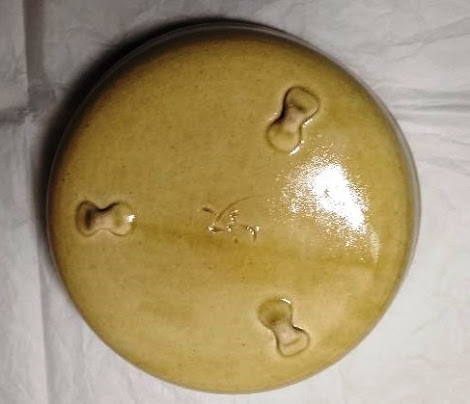3. SHIBATA Masumi 柴田増三 (1952- ), ki-Seto hachi (yellow Seto-ware serving bowl
Shibata comes from a family of potters
in Gifu Prefecture. He graduated from Tajimi Technical High School, Department
of Ceramics, and completed the course at Gifu Prefectural Ceramics Research
Institute. He established the Jōgama 城窯
kiln in Mizunami City while assisting his family’s pottery-making
business. He has received awards at the Japan Traditional Craft Exhibition,
Japan Ceramic Art Exhibition, Chūnichi International Exhibition, Asahi Ceramic
Art Exhibition, among others. He produces large works in tenmoku and iron glaze, and tableware and vases in the Oribe,
Shino, and ki-Seto traditions. He is
a member of Japan Kogei Association. The
pronunciation of Shibata’s given name as “Masumi” is based on the Dictionary of Japanese Potters (online). The certificate of authenticity
from the seller (see below) gives the name as “Masuzō,” which would be a common
reading for the name.
Fine white clay, with
yellow and green glazes. The bottoms of the three small feet attached to the
base of the bowl were left unglazed. The bottom of the bowl is circular. At the
rim of the bowl, the sides were squared off, creating a rough four-sided
figure with curved corners and sides. Weight: 818 g (1.8 lb); Rim dimensions:
18.5 x 18.5 cm (7-1/4 x 7-1/4 in); base diameter: 19 cm (7.5 in). Height: 8 cm
(3-1/8 in).
The clay available in Seto
is a high-quality kaolin and porcelain stone, which turns white when fired. Ki-Seto (黄瀬戸) , or
“yellow Seto,” is one of the typical glazes of the Seto kilns. The outline
of the turnip and the edges and veins of the leaves were incised into the clay
with a sharp, narrow-tipped tool. The turnip was drawn only in outline; the
leaves were painted with the green glaze, which pooled into the incised lines
of the edges and the veins, creating darker areas.
The piece came in a wooden
box with 黄瀬戸鉢 (ki-Seto hachi,
yellow Seto bowl) written in black ink on the upper right side of the
lid. In the lower left-hand side is 増三, the
given name of the potter, written in both black ink and stamped in red with a
seal. Included with the box was a
stamped certificate of authenticity in English from the Ma-shi-ko Folkcraft gallery
in San Francisco and a small printed sheet from Shibata with details about the Jōgama kiln and a short biography and a list
of rewards he has received.
Purchased in the late 1980s
at Ma-shi-ko Folkcraft, in the Japan Trade Center in San Francisco.









No comments:
Post a Comment